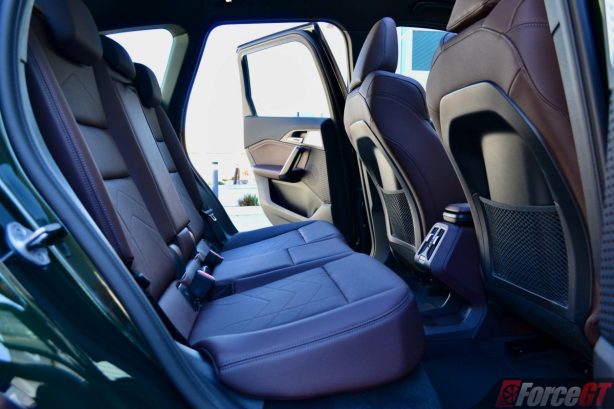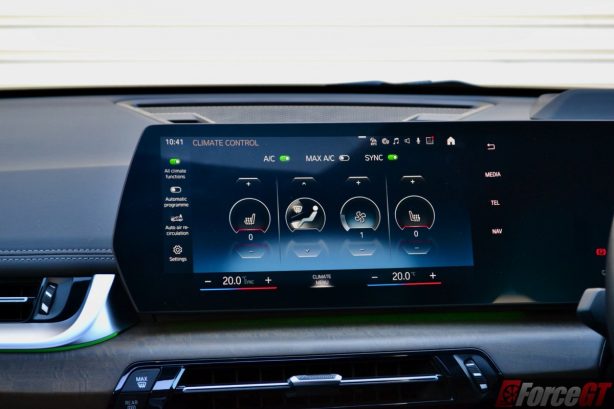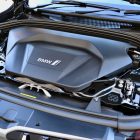BMW is no stranger to electric cars. It’s first foray into the world of EV was in 1972 with the 1602e, a concept car that was used to lead a pack of long-distance runners at the 1972 Munich Olympic games. More test cars were produced by the German carmaker in the subsequent decades, but it wasn’t until the 2010s that the company got serious about EVs, with the i3 and i8 becoming some of the first series production BMW EVs.
Today, there’s a whole range of zero emission models in BMW’s portfolio, but the success of the brand’s EV strategy really depends on just one particular model. The iX1 is the smallest and most affordable BMW EV on sale right now. As a compact electric SUV, it competes in the fastest growing EV segment, currently dominated by the Tesla Model Y.
The iX1 comes in two flavours, the front-wheel drive eDrive20 xLine is priced at $78,900 while the better spec’ed, more powerful and all-wheel drive xDrive30 xLine costs $84,900. All prices exclude on-road costs and the latter is also available in M Sport trim at no extra premium.
At the price sensitive end of the EV market, the iX1 is a pricey option. Comparing equal rival models from the luxury space, the BMW is undercut by the Tesla Model Y, Lexus UX 300e and Volvo XC40 Recharge, leaving only the Mercedes-Benz EQA being the more expensive competitor. In the mainstream space, the Hyundai IONIQ 5 and Kia EV6 both cost less.
Has BMW got its iX1 pricing strategy right to disrupt the Model Ys dominance and fend off other luxury rivals? The answer lies much deeper below the iX1’s sheetmetal.
But for starters, the iX1’s design is worth some discussion. Essentially, the iX1 is the electric version of the third-generation X1 SUV, which in itself is a good looking vehicle with clean lines and neat detailing. The iX1’s styling is mostly similar to the X1, albeit with a closed off kidney grille which some may find a little tacky and plasticky.
Our test vehicle was xDrive30 xLine variant which came with a more subtle and elegant undertone compared to the M Sport grade. The test car’s San Remo Green metallic colour is quite unique and makes the car look bigger than it actually is.
The interior makes a really good impression the moment you hop inside. Contemporary design shines throughout the whole cabin, with a clutter-free dashboard blending in harmoniously with luxury detailing and sporty touches. There’s nothing excessive, unnecessary or unsightly about the interior. Build quality is exceptionally high, so are the materials used throughout. The Eucalyptus open-pore wood trim feels and looks like it came from a 7 Series flagship and the Mocha leather upholstery gives such a sense of warmth. This is no doubt one of the best interiors in class, and certainly trumps over the Model Y’s.
There’s some seriously clever packaging in here, too. The wireless phone charging pad, for instance, has a near vertical orientation so as to not take up too much space in the centre console. An adjustable flap keeps your phone secured in this position, nice. The dual cup holders in front of the charger are decent in size, so are those bottle holders in the door bins.
Being an EV, there’s no transmission tunnel underneath the centre console and so this frees up space for a large open storage shelf under the front centre armrest. The trade off is that the covered centre storage bin is too shallow and only good for storing keys, access cards and the odds and bobs.
The front seats are cocooning without being overly snug like those found in other small cars. They have massaging functions (optional) and are heated but sadly not ventilated. Both front seats have power adjustment but only the driver seat has memory function.
For a compact SUV, cabin space is generous throughout. We’re pleasantly surprised by the room offered in the back. Even those stretched in the legs have decent leg and knee room to be comfortable back there. Also, the lack of a centre hump is surely welcomed by the middle rear passenger.
Further back, the boot has a capacity of 490 litres, down 50 litres on the engine-powered X1 due to the battery pack and electric motor but still of a decent size. Uncommon in this class, the 40:20:40 split folding rear seats afford good versatility. You can drop just the middle rear seat to carry long items such as a surf board while still keeping the outboard seats usable, or tumble them all to expand the boot space to 1495 litres.
In terms of standard equipment, the iX1 features dual-zone climate control, keyless entry and start, powered tailgate, adaptive LED headlights with high-beam assist and adaptive suspension. Our tester has been fitted with the optional $3,616 Enhancement Package which brings the aforementioned massaging function to the front seats, a 12-speaker Harman/Kardon sound system and a panoramic glass sunroof.
On the technology front, the iX1 boasts a curved multi display panel consisting of a 10.25-inch instrumentation display and a 10.7-inch centre touchscreen. Both displays offer good customisability including map view on the instrument cluster. Along with the head-up display, the cockpit is one of the most advanced in class.
Satellite navigation and DAB+ radio are standard, so is wireless Apple CarPlay and wireless Android Auto connectivity. There’re two USB-C ports at the front and two more at the rear. A 12V socket is fitted in rear centre console and another in the cargo area. As mentioned, a wireless phone charger is also featured.
Some may find that BMW has gone a step too far by integrating all climate control functions into the touchscreen but we don’t really mind it. The touchscreen is absolutely superb when it comes to clarity, responsiveness and ease of use. The climate menu and cabin temperature controls are always present at the bottom of the screen, with the buttons placed far apart enough for easy operation. You do, however, have to dive into the climate menu to activate seat heating and massaging functions. Alternatively, you could summon the voice control for these functions, which worked just fine during our test period.
The drive selector and media controls are located in the centre console, while the iDrive system is gone given the move to touchscreen, making this space a lot tidier. It’s also more comfortable to operate than before as you could rest your arm on the padded arm rest while your hand operates the switchgear.
The iX1 xDrive30 tested here is a direct EV equivalent of the petrol-powered X1 M35i xDrive. As such it has all-wheel drive courtesy of two electric motors, one on each axle. They are powered by a 66.5kWh lithium-ion battery pack stuffed in the floor. The electrical drive system outputs a total of 230kW and 494Nm, the latter figure is almost 100Nm more than the X1 M35i.
The sprint from 0 to 100km/h takes just 5.6 seconds, which is more performance than what most compact SUV owners ever need. The Tesla Model Y AWD Long Range is still quicker though, claiming 5.0 seconds for the same feat.
Being quick off the line isn’t what the iX1 is all about, for it delivers some of the best driving experiences offered by any EV. The drivetrain is refined, the steering is beautifully weighted and the pedals are nicely progressive. The AWD puts power down to the road neatly at every launch and once on the move the abundance of traction affords the iX1 with a secured, planted driving feel. Push the SUV further, the taut chassis and quick steering combine to deliver sharp, confidence inspiring dynamics, exactly what you’d expect from a BMW.
More often than not, sporty handling means compromised ride comfort. That’s not the case with the iX1. The SUV still rides with good compliance across varying road surfaces, thanks to the adaptive suspension and expertly tuned dampers. The ride and handling balance is just exemplary.
The iX1’s regenerative braking is also pretty good. In addition to having the ability to adjust the intensity of regenerative braking, it goes a step further by offering adaptive brake recuperation. Essentially, the car scans the traffic and road condition ahead and adjusts regenerative braking accordingly. On a stretch of empty road, recuperation is dialled right down to allow for coasting, and when a car is detected ahead or driving downhill recuperation becomes stronger thus slowing the car down. It’s like an adaptive self-braking feature and it works like a charm. Impressive stuff.
What isn’t is the range. With a claimed range of 440km on the WLTP cycle, it’s down substantially on the Model Y Long Range (533km). It also can’t match the Kia EV6 (484km) or Volvo XC40 Recharge Twin (485km). And when compared to its petrol-powered counterpart, the X1 M35i xDrive, it’s short as well, with the X1 capable of 692km. With nearly 500km travelled over varying roads and traffic conditions during our week-long test, the iX1 indicated an average consumption figure of 19.0kWh/100km. This equates to about 410km of range in the real world.
While the iX1 may require more frequent charging, it supports DC fast charging at up to 130kW. At this charge rate, the battery is replenished from 10 to 80 percent in about 30 minutes. One interesting feature of the iX1 is the ability to precondition the battery before a charge when using the built-in navigation to locate a suitable charger. We did not get to test this feature out, but theoretically the car can accept a charge at 130kW with no ramp-up, shortening charge time further.
Standard 11kW AC charging is also accepted, with an optional 22kW home charger available from BMW at a cost of $1199 plus installation. Owners get three years complimentary ChargeFox subscription for free charging throughout the ChargeFox charging network.
The iX1 is covered by a five-year factory warranty with no cap on kilometres and three years of included roadside assist.
Verdict
Design & Comfort
Performance & Handling
Quality
Economy
Equipment & Features
OUR SCORE
4.1/5
+ Plus
- Well packaged
- Luxuriously appointed
- Strong EV performance without the quirkiness
– Minus
- Pricier than most rivals
- Shorter range than similar Tesla models
- Some climate controls hidden in touchscreen
Overall
The BMW iX1 is one of many EVs on the market today that are based on their respective engine-powered counterparts, as opposed to built-from-the-ground-up EVs like Tesla’s and Polestar’s.
We usually don’t have much expectations from the former group. However, the iX1 manages to impress on nearly all fronts, delivering a highly satisfying electrically propelled drive without losing the kind of sporting flavours or luxury appointments expected of a BMW.
While the asking price is steep and the driving range is shorter compared to rivals, the iX1 is a desirable compact SUV that is definitely worth considering for anyone wishing to jump on the EV bandwagon.
2023 BMW iX1 xDrive30 Pricing and Specification
| Price (Excl. on-road costs): | From: $84,900 As tested: $88,516 (with Enhancement Pack) |
| Warranty: | 5 years/Unlimited kilometers |
| Country of Origin: | Germany |
| Service Intervals: | Variable |
| Power unit | Dual electric motors, lithium-ion battery 230kW / 494Nm |
| Drivetrain: | All-wheel drive |
| Power to Weight Ratio (kW/t): | 114.4 |
| 0-100km/h (s): | 5.6 |
| Combined Fuel Consumption (L/100km): | Claimed: 18.3kWh/100km Tested: 19.0kWh/100km |
| Body: | 5-door SUV, 5 seats |
| Safety: | 5-star ANCAP, 7 Airbags, Parking Assistant, Surround View, Tyre Pressure Sensor, Emergency Stop Signal, Hill Descent Control (HDC), ABS, BA, TCS, EBD |
| Dimensions (L/W/H/W-B) mm: | 4500/1845/1642/2692 |
| Kerb Weight (kg): | 2010 |
| Towing Capacity (kg): | Braked: 1,200kg / Unbraked: 750kg |
| Entertainment: | 10.7-inch colour touch display, 6-speaker (12-speakers Harman Kardon optional), Bluetooth/USB, wireless Apple CarPlay, wireless Android Auto |
 ForceGT.com Car News, Car Reviews, Video Reviews, Tuning and much more.
ForceGT.com Car News, Car Reviews, Video Reviews, Tuning and much more. 

























































































